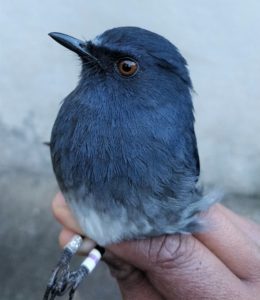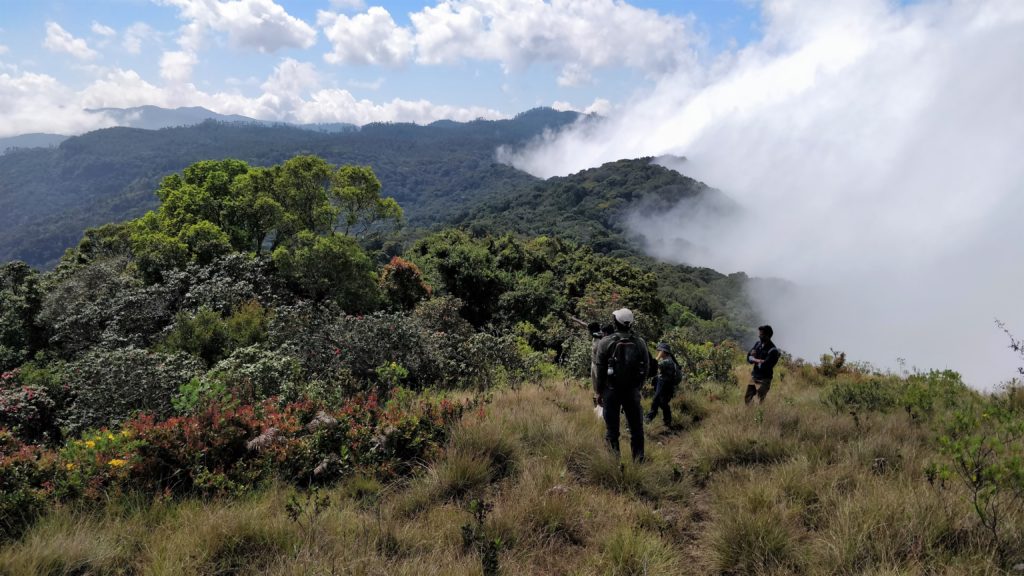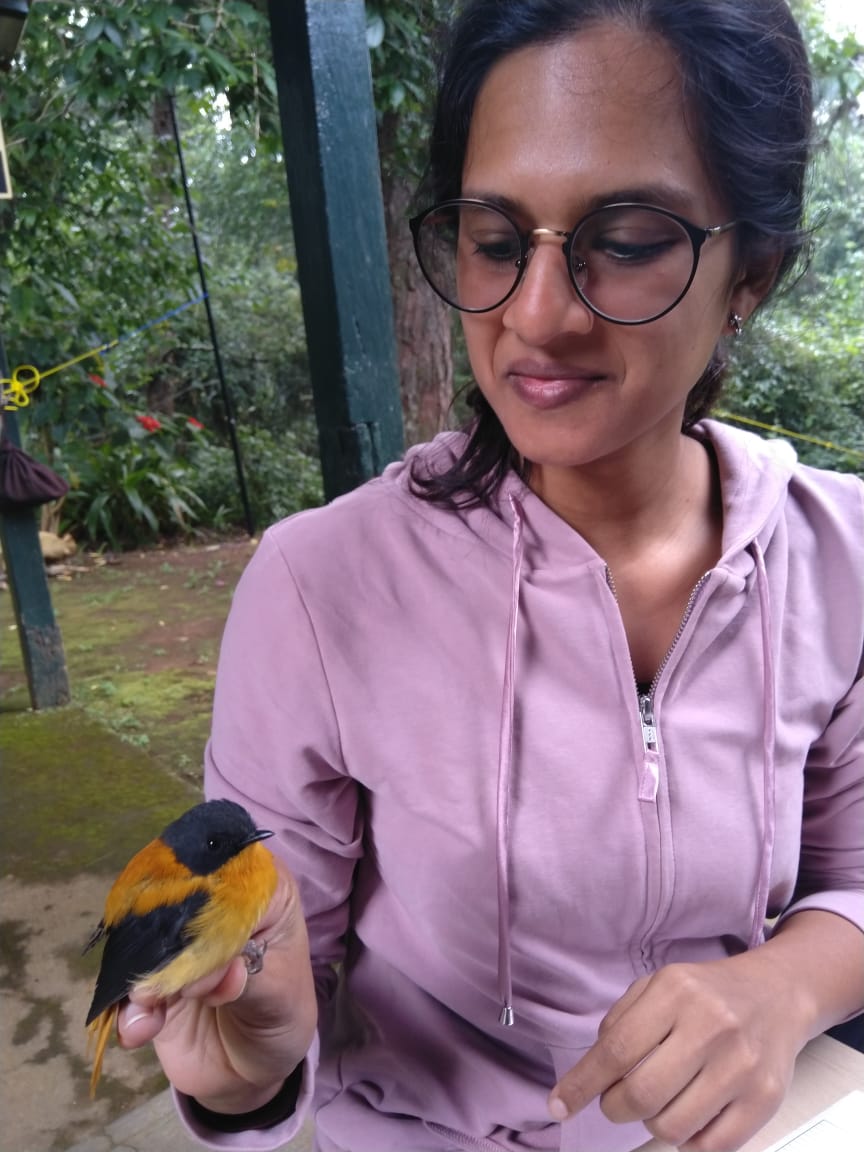As part of my first research project, I was counting flock sizes of mynas leaving a bamboo clump (their roost) at dawn. Two hours had passed, and it was nearing 7 am when I spotted a Shikra settle on the adjacent terrace – its eyes were fixed on the roost. I had seen mock attacks before. But this shikra was on a mission – it swooped straight into the centre of the roost. This was accompanied by a cacophony of noise and an explosion of remaining mynas from the bamboo clump. The Shikra emerged with its target clutched in its claws. Perched on a tree nearby, well within view – I observed the feeble cries of the myna slowly fade. I remember being awestruck by this incident!
This is how my love for birds took shape…
Until the age of ten, my childhood was spent in the foothills of the Himalayas in Dehradun. I intently observed the birds that visited my backyard, though I didn’t know many of their names. For the longest time, I referred to sunbirds as hummingbirds till a student brought the remains of a Purple-rumped Sunbird to class one day- and I was promptly educated on what it was. Growing up, I remember actively visiting science exhibitions and fairs with my parents and on one occasion I returned home with a tiny compound microscope. I intently observed anything that fitted under the lens; be it spider legs, flower petals, leaves and even pollen from hibiscus flowers. This curiosity-driven behaviour persisted, and biology remained one of my favourite subjects throughout school – credit goes to all the amazing teachers I have had. It was only during my BSc in Life Science at Sophia College in Mumbai that I began actively birding. A colleague from my summer internship lab, Purabi Deshpande, introduced me to Sunday birding at Lalbaug and this was when I realised there is a whole big birding community. Bird identification was overwhelming initially, but gradually learning about distinguishing features and behaviours helped a lot.
Apart from various bird-centric internships, bird ringing with the British Trust of Ornithology was another aspect that strongly drew me towards avian research. Over a year, our trainer Colin Wilson patiently taught us how to set up mist-nets and ring birds through snow or sunshine! It was always fun during the migration season, getting recaptures from the previous year and sometimes even encountering birds with rings from other countries. I still continue to learn a lot about birds and other taxa from my colleagues at IISER Tirupati. It is great to be a part of a diverse community of students here that even a birding ‘trip’ without seeing ‘many’ birds is exciting because invertebrates become the day’s highlight!
While pursuing my BSc, I was fortunate to be part of a 3-year summer fellowship at JNCASR, Bangalore. It was here that I had my first formal research experience working in Dr TNC Vidya’s lab where we looked at the communal roosting behaviour of the Common myna (anecdote from this experience above). Here I got a chance to experience the nuances of experimental design and fieldwork and also navigate through the process of data analysis and scientific writing. Post this; I was fortunate to secure another exciting summer internship during my Masters via the Khorana Scholar Exchange Program at the Smithsonian Tropical Research Institute in Panama with Dr Christina Riehl. Here I was a part of a project that looked at the communal nesting behaviour of the Greater Ani, a neotropical cuckoo. We spent our field time manoeuvring our boat through the Panama Canal, searching for nests in foliage overhanging the water, and setting up nest cameras in precarious (yet concealed) locations. I was also assisting a PhD student in collecting vocalisations of these birds. On one occasion, while recording, our shotgun mic – positioned on a boom pole – fell and slipped straight into the canal. A heart-in-mouth moment indeed, but luckily sticking the mic in a bag of rice for three days saved it (thank god!). These internships significantly contributed to my decision to study birds ahead, and I am forever grateful to my advisors and lab seniors for their mentorship.
 Sampling site of the Greater Ani in the Panama Canal, a view from Barro Colorado Island research station.
Sampling site of the Greater Ani in the Panama Canal, a view from Barro Colorado Island research station.
On completing my Master’s in Life Sciences from Mount Carmel College in Bangalore in 2016, I had a brief stint working with shorebirds and waders at BNHS along the coastline of Navi Mumbai. I realised that I required formal training in ecology, and I took up another specialised Master’s degree at Imperial College London, which involved two major projects. One looked at how prenatal maternal investment buffered against environmental stress in a captive population of Japanese quail at the Institute for Avian Research, Germany with Dr Sandra Bouwhuis, Dr Oscar Vedder and Dr Julia Schroeder. The other project was examining the evolution of sexual selection and birdsong complexity in suboscines with Dr Joe Tobias. Birdsong and bioacoustics were always intriguing concepts, and the latter project seeded my enthusiasm in this field. I then got the opportunity to work on a passive acoustics project with Dr V V Robin at IISER Tirupati. Together with a team of collaborators, we developed a detection framework to detect Critically Endangered bird, Jerdon’s Courser. This project took me through an entire research experience, from securing a small grant (via the Wildlife Conservation Trust) to writing it up. I now continue my research in the same lab as a part of my PhD.
I currently work broadly on avian bioacoustics with Dr V V Robin. I am looking at the cultural diversity of birdsong dialects in the White-bellied Sholakili, a bird endemic to the Shola Sky Islands. I am also interested in exploring whether song complexity has any fitness level benefits, and this species forms an excellent study system because it has a highly complex song!
 A ringed individual of the White-bellied Sholakili. This bird is often difficult to spot but easily heard due to its loud characteristic vocalizations.
A ringed individual of the White-bellied Sholakili. This bird is often difficult to spot but easily heard due to its loud characteristic vocalizations.
I love what I do because…
It would be cliche to say – not being tied to the desk, but this is a strong driving factor. The Shola forests can be described as magical (perhaps not so much when the ground is alive with leeches..haha) and fieldwork is exciting. Another significant aspect of my work is that it allows me to engage with fellow researchers with different research interests, and often impromptu discussions result in some great ideas!
 One of our field site surveys in the Shola Sky Islands near Kodaikanal.
One of our field site surveys in the Shola Sky Islands near Kodaikanal.
Challenges I have faced..
Having done a BSc and an MSc in Life Sciences, my experience in the field of ecology was only through short stints of summer internships. When applying for PhDs it was often (but not always) indicated that I lacked formal educational experience and should do a specialised master’s in the field, which is ultimately what I did. So in my opinion, one is at an advantage if you pursue a Masters’s degree from either – one of the (few) institutes that offer specialised MSc programs in ecology/wildlife conservation in the country or a degree from one of the recognised government institutes. There is usually a quest to accumulate research experience, and at times funding may crop up as a major concern.
Fieldwork does come with its fair share of logistical challenges; most importantly, when there are women on a team, ensuring safety is a key component. Apart from this, being able to drive really helps. Three cheers to my labmates, who have patiently sat next to me during my learning curve!
My advice to young researchers is..
Things TO DO..
- If you are starting out in this field, join a birding/naturalist club in your society, city, institute – keep your mind open to exploring not only birds but everything in your surroundings.
- The Ornithology course run by NPTEL is a great resource to learn more about birds from the top scientists in the country. The discussion sessions serve as a great platform to interact with these professors, and I wish we had such opportunities before.
- Reach out to people you are interested in working with. Be persistent; many may not respond, but many will take the time out to interact with you!
- Several internships and fellowship opportunities are available in India and abroad that can give you first-hand exposure to scientific research in this field.
- Engage in discussions with your colleagues; collaborations can result in valuable projects. Work towards your strengths and involve others who have allied strengths. It is unlikely that you will become an expert in everything.
Things TO AVOID..
- Don’t undermine your ability to be an ornithologist if you cannot identify all the birds that come your way. Often in this field, the ability to identify more/every bird species is perceived as your passion for the subject. Don’t worry, this is not the case and it is a common misconception. 🙂 Just keep an open mind to learn.
- Don’t hesitate to ask questions, often the other person is more than happy to clear your doubts.
Chiti Arvind
[email protected]
PhD student, Dept. of Biology
IISER, Tirupati
Lab Webpage: https://www.skyisland.in/chiti.html
Twitter: https://twitter.com/ChitiArvind


Thank you for sharing your wonderful experiences . This will definitely be a guide to those who want to pursue this field . All the best in your future endeavours in following your passion .
Interesting readong. How she stepping up a step at time. Her devotion and patience paid off.
Many or most student devote their carrier in traditional field which attract hepty package. But this field gives satiesfaction and love by nature.
Most inspiring journey. The writer is so lucky to be able to spend time in unspoilt nature. You have got the amateur in me to pursue this interest further!